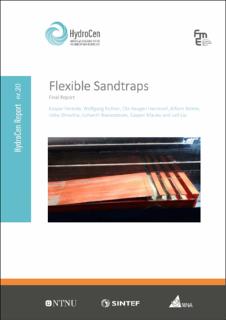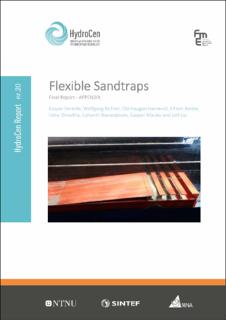| dc.description.abstract | The Flexible Sandtraps (FlekS) project has been a four-year research project on upgrading of existing pressurized sandtraps in operational hydropower plants. Upgrading of existing sandtraps have several challenges compared with construction of new sandtraps; (i) limitations imposed by the existing infrastructure and (ii) the need to limit downtime to avoid production losses. The purpose of FlekS has thus been to develop cost-efficient solutions that can be installed with limited downtime to retrofit existing sandtraps in operational hydropower plants.
The project has been divided in three main activities; (A1) literature review and mapping of challenges in the hydropower industry, (A2) numerical simulations of preliminary concepts, and (A3) physical modelling of the most promising concepts. The literature review and mapping of challenges in the industry reveals that hydropower plants comprising over 8000 MW equaling about 25% of the total installed capacity in Norway have experienced challenges with silt, sand or gravel transported during operation. The challenges range from slightly faster than expected wear on the turbine to severe damages on the turbines and operational restrictions. Almost all these hydropower plants have existing pressurized sandtraps at the downstream end of the unlined headrace tunnel. Common for all is that a well-functioning sandtrap may be able to mitigate the challenges.
To find potential concepts for upgrading of existing sandtraps, numerical simulations and physical scale modelling have been applied. The sandtrap no. III at the 960 MW Tonstad hydropower plant has been used as a case study. Several field trips have been conducted and detailed information from the case-study has been made available, including a full 3D scan, velocity profile measurements from three ADCPs, pictures and videos taken during operation from a camera installed inside, and samples of the trapped material inside. The field data has been used to calibrate the numerical simulations and physical models. These tools have thereafter been used to test several different concepts for upgrading of existing sandtraps.
In conclusion, it is found possible to upgrade existing sandtraps with limited downtime and costs. The main conclusions from the FlekS research project are presented below.
1. Hydropower plants comprising over 25% of the total installed capacity in Norway have experience challenges related to transport of silt, sand and gravel during operation. Many existing sandtraps do not function satisfactory.
2. The FlekS-project confirms previous research that the closed type of sandtraps is superior compared with the open type of sandtrap for trapping of bed load. The main difference is that the closed type successfully separates the deposited material from the main water flow, preventing further transport as bed load or resuspension.
3. An efficient solution for upgrading of open sandtraps to closed sandtraps has been developed. The solution entails limited construction works in the downstream end of the sandtrap and does not require expanding of the sandtrap volume. This solution has been recommended for the upgrading of the case-study sandtrap at Tonstad power plant. Physical model tests at TU Graz indicate that this solution can increase the trap efficiency from 0% to 90% for particle sizes in the range 0.3 to 1 mm. Physical model tests at NTNU for particle sizes with d50 equal to 3 mm do not show any significant different in the trap efficiency for tests with and without ribs (about 87% for both situations).
4. The proposed solution includes the use of a flushing system, which is necessary to enable the minimum reconstruction works inside the sandtrap. Flushing systems are in general found to be a promising measure when upgrading existing sandtraps. Most of the Norwegian sandtraps reviewed in this work do not have a flushing system and require dewatering and manual removal of the deposited material. Flushing systems allow emptying of the deposited material without dewatering the sandtrap and will hence reduce both outage and the stress on the tunnel stability resulting from a dewatering.
5. The results concerning the effect of flow calming structures on the trap efficiency of sandtraps are inconclusive. Some tests show a positive effect, and some show a negative effect. A concept with a passable flow calming structure was developed, allowing personnel and machines to pass the structure without dismantling during dewatering.
6. Heightening of the downstream weir was not found to have any effect on the trap efficiency. However, it can have a positive effect by preventing free surface flow with high velocities in the sandtrap.
7. Geometrical improvements are usually possible in existing sandtraps. Sudden expansions, contractions and abrupt changes in the geometry will cause turbulence and can decrease the trap efficiency of sandtraps.
8. For power plants where the sandtrap is constructed in conjunction with a surge tank, a new innovative solution for combined upgrading of the surge tank is developed. The “semi-air cushion surge tank” is able to increase the capacity of both the upper and lower surge chamber of two-chamber surge tanks with only expanding the volume of the lower chamber. Upgrading of the sandtrap may enable upgrading of the installed capacity in hydropower plants.
9. Physical model tests were not able to confirm any significant difference in trap efficiency for stable operation and transient operation of hydropower plants. However, only one test to investigate this effect was conducted and further research is necessary to conclude.
The results presented above are primarily based on the results from the physical scale models. However, it is experienced that numerical simulations and physical modelling and variations of the two methods gave significantly different results. Three different numerical simulation software were applied by different users and with different setup, and two different scaling methods for the physical modelling were applied. By comparing with the sand deposition in the field measurements, the results from the physical scale model from TU Graz seems to be most representative.
Developing scaling methods has not been an objective in the FlekS-project, and further research is necessary to investigate the accuracy of the two different scaling methods. Tests in the TU Graz model with the equivalent same sand size as applied in the NTNU model are planned to check if the difference in results is still significant. Tests are also planned to be conducted according to the Euler scaling method with lightweight material (natural sand is not possible at scale 1:37 owing to cohesion). Also, field data from the future case-study Tonstad sandtrap with installation of the ramp and a short section with ribs, will provide more information to validate the physical scale models. Further investigation of the numerical simulations methods is also required. The turbulence models and necessary resolution, in addition to the particle simulation and two-way coupling between water and particles needs further testing to give credibility as a design method for pressurized sandtraps.
A PhD project in HydroCen will continue parts of the work described in this report. The physical models, the field data, and the 3D geometry are still available for future research, teaching and master thesis work. | en_US |

